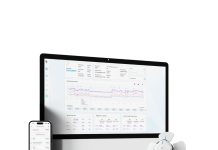Smart stethoscope company Eko received a $2.7 million grant from the National Institutes of Health, and Halo raised $2.6 million for its research and development collaboration tool.
Lyfegen, which offers a platform for value-based contracting for high-cost drugs, announced it had raised $8 million in Series A funding.
The round was led by aMoon, with participation from APEX Ventures and other investors. The startup, which is headquartered in Switzerland and the U.S., offers software that aims to help pharma companies, payers, providers and medical technology companies adopt value-based contracts. It includes a library of contracts, tools to simulate how models will work before implementing them, and data collection to track performance and outcomes.
“We currently work with leading government payers and health insurance companies in Europe, the U.S. and the Middle East, and some of the world’s largest pharma companies,” Girisha Fernando, CEO and founder of Lyfegen, said in a statement.
“Our plan now is to further expand our presence in the U.S., partnering with both private and public healthcare insurance companies. The move away from volume-based healthcare has never been more needed, and we are happy to play an important role in the shift to value-based contracting.”
Smart stethoscope company Eko received a $2.7 million grant from the National Institutes of Health to develop a machine learning algorithm that detects and classifies pulmonary hypertension.
The Small Business Innovation Research (SBIR) Direct Phase II grant will go toward an algorithm that uses phonocardiogram (PCG) and electrocardiogram (ECG) data collected by Eko’s stethoscopes to find pulmonary hypertension, or high blood pressure, that affects arteries in the lungs and the right side of heart.
Eko has previously partnered with Lifespan Health System’s Cardiovascular Institute to collect real-world PCG and ECG data that will be part of the algorithm’s development.
“The major goal of this study is to determine whether an Eko algorithm based on phonocardiography coupled with electrocardiography can identify the presence and severity of pulmonary hypertension when compared to the current gold standard,” said Dr. Gaurav Choudhary, principal investigator and director of cardiovascular research at the Lifespan Cardiovascular Institute.
“This machine learning algorithm has the potential to be a low cost, easily implementable and sustainable medical technology that assists healthcare professionals in identifying more patients with pulmonary hypertension.”
Eko said this is their fourth SBIR grant. The company recently received FDA 510(k) clearance for an algorithm that detects and characterizes heart murmurs in adult and pediatric patients.
Halo, which offers a platform that aims to connect companies and scientists for research and development, raised $2.6 million in seed funding.
Participants in the round include Asymmetric Capital Partners, Village Global, AirAngels, 23andMe cofounder and CEO Anne Wojcicki, cofounder and CTO of email client Superhuman Conrad Irwin, and Rachel Hepworth, head of marketing at organizational software company Notion.
The platform allows biopharma, medical device, consumer goods and agriculture companies to post requests for proposals for specific needs or open calls around general research interests. Scientists can then respond with their proposals, and companies can select researchers for partnerships.
Halo plans to use the seed to hire new workers, develop new collaboration features on the platform and expand its network of scientists.
“Collaborating in R&D is just as much about relationships as it is about the research itself. However, companies still rely on practices that don’t scale, like hearing a talk at a conference or reading a journal article. This limits businesses to a handful of existing relationships and pure happenstance,” Kevin Leland, founder and CEO of Halo, said in a statement.
“Halo connects corporate R&D teams directly with scientists. Through our platform, we engineer serendipity so companies can quickly and easily scout for new technologies, expand their networks globally and build relationships with scientists year round.”






